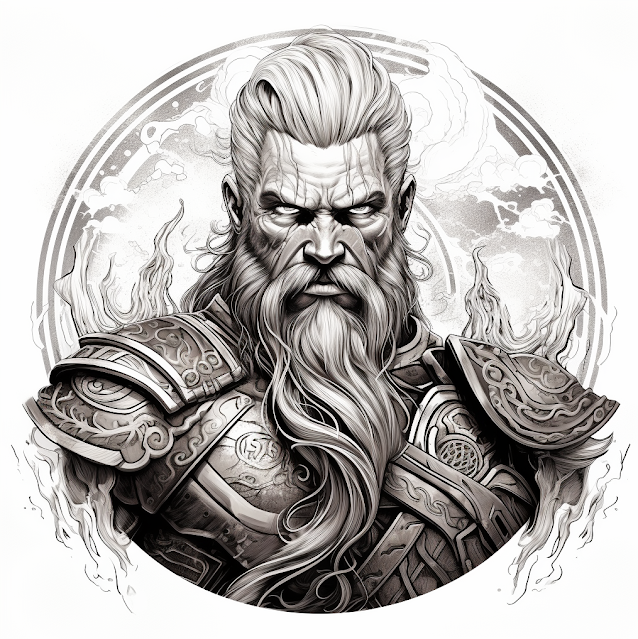I am working on my next Myths & Monsters series, this time on the Ptolemaic Myths of the combined Greek and Egyptian pantheons of the Ptolemaic rule of Egypt. While the poster children for these myths are Serapis and Hermes Trismegistus, I want to focus on a goddess who is, as far as I know, fairly unique.
While I am leaning heavily on academic scholarship here for this one, that only takes me so far. And in truth, if I am going to come up with my syncretic god here, it might as well be a Goddess of Witchcraft and Magic.
Thankfully, one such goddess sprang, fully formed like Athena, from my mind. Or very nearly fully formed.
Heqate, Queen of Heka and the Crossroads Eternal
This Wednesday, I want to return to the Ptolemaic Myths specifically, to the goddess known as Heqate (formerly Heka here), the Witch Queen of the Two Lands and the living embodiment of heka. This is not simply Hecate with great eyeliner, nor Heqet with a torch and dogs, nor even a distaff Heka or a Greek Weret Hekau. This is a syncretic goddess of magic, liminality, birth-life-death-rebirth, and arcane will, forged where Greek moon sorcery meets Egyptian divine speech.
If you've ever wanted to play a moonlit necromancer-priestess, a midwife-witch who communes with ghosts, or a seer whose scrolls bleed truth, this is your goddess.
Heqate: The Torchbearer of the Threshold
In older Greek traditions, Hecate was already something liminal, goddess of the crossroads, of the moon, of ghosts, and witchcraft. And, of death, the ultimate threshold. In Egypt, the frog-headed Heqet presided over childbirth, resurrection, and divine protection in the womb and tomb alike. Add to this the Egyptian concept of heka (lower case, not the god Heka), not magic as trickery, but as cosmic creative force, and Weret Hekau, the Egyptian personification of supernatural powers, you get something entirely new.
In the Ptolemaic imagination, these figures blur into one divine presence:
Heqate, the Queen of Witches, the Scribe of Names, the Midwife of Magic.
- She carries torches of silver flame, revealing the paths between life and death and rebirth.
- She speaks true names, unraveling illusions, enchantments, and lies.
- She presides over birthing chambers and funerary rites, the first breath and the last silence.
- Her voice is heka, and her will becomes ritual law.
The Three Faces of the Liminal Witch
Followers of Heqate often describe her as having three aspects (I can't resist a good Maiden-Mother-Crone tri-aspect):
- The Maiden of Moonlight – Patron of seers, dreamers, and witches-in-training. She guards hidden knowledge and initiations.
- The Mother of Torches – Midwife and ward-breaker. She protects the soul at its most vulnerable.
- The Crone of Ash and Word – Keeper of forbidden names and the judgment of oaths. Her word is binding.
Temples and covens devoted to her often use three altars—one facing the door, one the hearth, and one a mirror.
Final Thoughts
Heqate isn’t just a rebranding. She’s a bridge goddess, walking between systems, just as witches walk between divine and arcane, mortal and otherworld, life and death. She offers you a chance to center magic not as firepower, but as language, ritual, and transformation.
The Ptolemies ruled over Egypt as Greek-speaking elites, and their greatest symbol wasn’t a weapon or a crown, it was a library. The Great Library of Alexandria was the beating heart of the Ptolemaic worldview: knowledge as power, preservation as control, language as law.
If Hermes Trismegistus is the figurehead of recorded wisdom, the scholar-priest who catalogues and measures, then Heqate is the figurehead of forbidden wisdom and occult knowledge, the whispered name, the unwritten charm, the scroll burned before it can be copied. She is the sorcerous opposite to Hermes’ alchemical order, not in opposition, but in complement. They are a cosmic argument between forms of knowing.
Do they oppose each other? Perhaps. No more than witches and wizards clash in how they practice magic. Perhaps this ancient rivalry echoes across the ages, playing out in coven and tower, scroll and staff, moon and mercury.
In any case, it is certainly a fun way to set up a god rivalry between wizards and witches in your worlds.
And if I am being honest. She would have great eyeliner and wear an ankh as a necklace.















